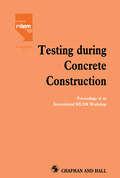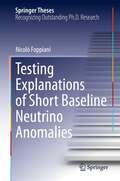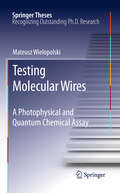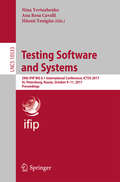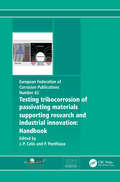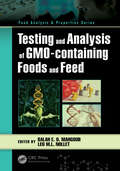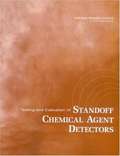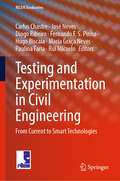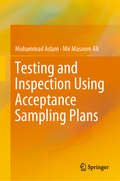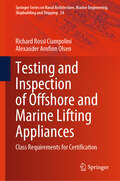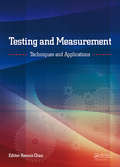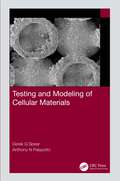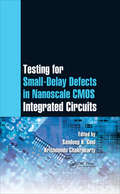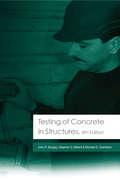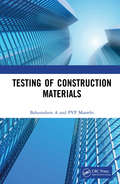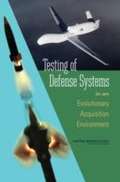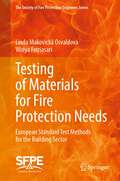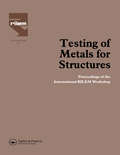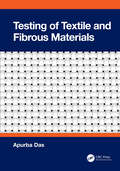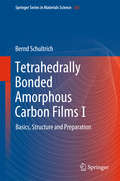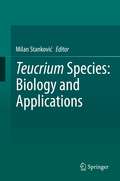- Table View
- List View
Testing During Concrete Construction: Proceedings of RILEM Colloquium, Darmstadt, March 1990
by H. W. ReinhardtTesting concrete while construction is underway enables decisions to be made which can improve the quality of the finished structure. The book covers testing and measuring techniques for fresh concrete and concrete during the first few days after placing, and for reinforcement and prestressing tendons. Many examples are given of practical methods w
Testing Explanations of Short Baseline Neutrino Anomalies (Springer Theses)
by Nicolò FoppianiThis thesis, encompassing both theory to experiment, guides the reader in a pedagogical way through the author’s attempts to resolve the mystery of the so-called MiniBooNE anomaly, where unexpected neutrino oscillations were reported, potentially explainable by the existence of light sterile neutrinos, but in contradiction with several null results. Within this context, this thesis reports one of the first analyses searching for an excess of electrons in the MicroBooNE experiment finding no excess of events and narrowing down the possible explanations for the anomaly. Additionally, this thesis explores non-minimal heavy neutral leptons as potential explanations for the MiniBooNE excess. To search for evidence for this particle, the author performs an analysis using data from the T2K experiment, which searched for pairs of electrons using a gas argon time projection. This thesis provides a comprehensive explanation of the MiniBooNE anomaly and test of its possibile explanation with liquid and gas time projection chambers.
Testing Molecular Wires
by Mateusz WielopolskiThe field of molecular electronics and organic photovoltaics is steadily growing. One of the major themes in molecular electronics is the construction, measurement, and understanding of the current-voltage response of an electronic circuit, in which molecules may act as conducting elements. The investigated molecular structures in this thesis have been shown to be suitable for distance-independent charge transport. More precisely, the systems investigated were of particular interest due to their ability to provide efficient electronic coupling between electroactive units, and display wire-like behavior in terms of transferring charges from donors to acceptors. Besides impacting on the field of molecular electronics, the results of this research also has applications in the design and development of light harvesting, photoconversion and catalytic modules. This work is a great asset to the field of charge transport through organic pi-conjugated molecules.
Testing Novel Water Oxidation Catalysts for Solar Fuels Production (PoliTO Springer Series)
by Carminna Ottone Simelys Hernández Marco Armandi Barbara BonelliThis book offers comprehensive information on the main techniques for measuring water-oxidation-catalyst (WOC) performance, with a particular focus on the combined use of sacrificial oxidants and dyes within closed-batch reactors. It provides an overview of the latest advances in the synthesis of more efficient WOCs, followed by an analysis of the requirements for sustainable energy production. Readers will find a detailed description of the reaction mechanism used in catalyst assessment systems, which reveals the benefits and limitations of the most common sacrificial oxidant/dye pair. Experimental techniques including electrochemical methods for characterizing novel and non-photoactive WOCs are also described. Throughout the book, various manganese oxides are used as examples of the techniques reviewed or proposed systems. Cost considerations and technological perspectives of the scale-up of solar-driven hydrogen production are also addressed. Lastly, the book presents lessons learned from the implementation of a large-scale real-world device.
Testing Software and Systems
by Nina Yevtushenko Ana Rosa Cavalli Hüsnü YenigünThis book constitutes the refereed proceedings of the 29th IFIP WG 6. 1 International Conference on Testing Software and Systems ICTSS 2017, held in St. Petersburg, Russia, in October 2017. The 18 full papers and 4 short papers presented were carefully reviewed and selected from 41 submissions. The topics of the volume cover model based testing; test derivation and monitoring; fault localization and system testing including real time systems.
Testing Tribocorrosion of Passivating Materials Supporting Research and Industrial Innovation: A Handbook (European Federation Of Corrosion Publications #62)
by Jean-Pierre CelisThis first edition of Testing Tribocorrosion of Passivating Materials Supporting Research and Industrial Innovation: A Handbook treats in a clear, concise, and practical manner an important material degradation and protection matter. It is designed as a handbook and provides a well structured approach of the basics needed to investigate the tribocorrosion behavior of passivating materials, and to conduct in a correct way a laboratory investigation on it. It provides answers on practical and theoretical approaches of tribocorrosion phenomena to engineers and medical persons involved with material assemblies subjected to aggressive environmental and mechanical conditions. For academic researchers it is a pertinent tool assisting them in how they can perform a tribocorrosion investigation and obtain results that are correctly interpreted and can be exchanged. Different parts of the book are illustrated with practical examples. This handbook is truly an indispensable guide for every professional who comes into contact with the complex material degradation and protection processes that take place under combined corrosion and wear conditions. Fields of interest include: transportation (aeronautics, maritime, rail, automotive), medical implants (orthopaedics, dentistry), biochemistry, food production, energy production, and machining. The coordination of this handbook writing was done by Professor Jean-Pierre Celis (Katholieke Universiteit Leuven, Belgium) and Professor Pierre Ponthiaux (Ecole Centrale Paris, France) assisted by twelve European experts who contributed jointly to the nine chapters of this handbook. Main topics dealt with are tribocorrosion phenomena in medical and industrial sectors, depassivation and repassivation phenomena, impact on synergism in tribocorrosion, specific testing techniques, coupling tribology-to-corrosion, design of a testing protocol, and normalisation.
Testing and Analysis of GMO-containing Foods and Feed (Food Analysis & Properties)
by Leo M. L. Nollet Salah E. O. MahgoubAn increasing number of genetically modified organisms (GMOs) continues to be produced every day. In response to the concerns raised by the development of GMOs and their incorporation in foods and feed, guidelines and regulations to govern and control the use of GMOs and their products have been enacted. These regulations necessitated the design of methods to detect and analyse the presence of GMOs or their products in agriculture produce, food and feed production chains. Design of techniques and instruments that would detect, identify, and quantify GM ingredients in food and feed will help inspection authorities to relay reliable information to consumers who might be concerned about the presence of GM ingredients. Information generated by detection of GMOs in food and feed would be helpful for setting regulations that govern the use of GM components as well as for labeling purposes. Qualitative detection methods of GM-DNA sequences in foods and feeds have evolved fast during the past few years. There is continuous need for the development of more advanced multi-detection systems and for periodic updates of the databases related to these systems. Testing and Analysis of GMO-containing Foods and Feed presents updates and comprehensive views on the various methods and techniques in use today for the detection, identification and quantification of GMOs in foods and feed. The eleven book chapters cover recent developments on sample preparation techniques, immunoassays methods and the PCR technique used in GMO analysis, the use of biosensors in relation to GMO analysis, the application of nucleic acid microarrays for the detection of GMOs, validation and standardization methods for GMO testing, in addition to the type of reference material and reference methods used in GMO testing and analysis. Some of the ISO standards designed for identifying and detecting the presence of GM material in foods are also presented in the book.
Testing and Balancing HVAC Air and Water Systems
by Samuel C. SugarmanThis thoroughly revised book will provide the reader with an understanding of the principles and practices of testing and balancing (TAB) heating, ventilating and air conditioning (HVAC) air and water systems. It is for anyone interested in testing and balancing. For the novice and the experienced testing and balancing technician, it is a field reference book of procedures, equations, and information tables. For those interested in getting into TAB or who are new to the HVAC industry, it is a text for learning more about HVAC systems and testing and balancing. For the mechanical engineer, building owner, facility manager, commissioning agency or energy manager, this book can be used for teaching TAB, writing more effective specifications, and learning about TAB and how it interacts with system commissioning, indoor air quality and energy management. It is the intent of this book to improve the communications between owners, mechanical engineers, designers, vendors, contractors, TAB engineers, supervisors, and technicians to ensure that HVAC systems are being thoroughly tested and balanced. This book is used in test and balance self-study courses, in-house training programs, seminars, and other training formats as preparation for TAB certification, and as a text in colleges and technical schools. The sixth edition has general and specific testing and balancing procedures for constant air volume systems, variable air volume systems, return air and exhaust air systems, positive and negative pressure conditioned spaces, and fans and fan performance in Chapters 1 through 9. Chapters 10–12 cover testing and balancing fume hood systems, and cleanrooms and commissioning HVAC systems. Chapters 13 and 14 provide information on water systems and centrifugal pumps including water balancing procedures using flow meters, system components and temperatures, and water pumps and pump performance. Chapter 15 reviews analog and digital controls. Chapters 16–20 cover terminology for fluid flow, psychrometrics, refrigeration¸ air distribution, water distribution, fans and pumps, motors, electrical, and instrument usage and care. Chapters 21 and 22 are equations and tables.
Testing and Characterisation of Earth-based Building Materials and Elements: State-of-the-Art Report of the RILEM TC 274-TCE (RILEM State-of-the-Art Reports #35)
by Jean-Claude Morel B. V. Venkatarama Reddy Antonin Fabbri Jean-Emmanuel Aubert Quoc-Bao Bui Domenico GallipoliThis book presents the work done by the RILEM Technical Committee 274-TCE. It focuses on the estimation of the parameters which are necessary to properly design earthen constructions. It provides a compilation of the value classically obtained for the key parameters of earthen materials, a pedagogical presentation of the main testing procedures for earthen materials, their advantage and their drawback and an overview of most standards on earthen materials, whatever their origin and their language.The book is divided into eight chapters. After a general introduction on earthen materials and constructions, the state of the art on the material characterisation technics, the assessment of hygrothermal performance, the mechanical behaviour, seismic resistance and the durability will be presented, each in a dedicated chapter. On the basis of these last chapters, a critical review of the standards which are used for earthen material will be presented in the last chapter. The last chapter is dedicated to the analysis of the environmental potential of earth-based building materials.
Testing and Evaluation of Standoff Chemical Agent Detectors
by National Research CouncilThe report provides an independent assessment of suitable test protocols that might be useful and reliable for the testing and evaluation of standoff chemical agent detectors. The report proposes two testing protocols, one for passive detectors and one for active detectors, to help ensure the reliable detection of a release of chemical warfare agents. The report determined that testing these detectors by release of chemical warfare agents into the atmosphere would not provide additional useful information on the effectiveness of these detectors than would a rigorous testing protocol using chemical agents in the laboratory combined with atmospheric release of simulated chemical warfare agents.
Testing and Experimentation in Civil Engineering: From Current to Smart Technologies (RILEM Bookseries #41)
by José Neves Diogo Ribeiro Carlos Chastre Maria Graça Neves Paulina Faria Fernando F. S. Pinho Hugo Biscaia Rui MicaeloThis book gathers the peer-reviewed selected papers presented at the 3rd International Conference on Testing and Experimentation in Civil Engineering (TEST&E 2022), held in Almada, Portugal, on June 21-23, 2022. It showcases the role of smart technologies in all civil engineering areas, such as structures and construction, geotechnics and natural resources, hydraulics and water resources, transportation and communication networks. The conference topics encompass big data and advanced data processing systems, AI applications, virtual and augmented reality, 3D modeling and printing, digital twins, automation, sensing and detection technologies, inspection, monitoring and automatic damage identification, destructive and non-destructive testing, bio, nano and new materials, disaster risk reduction and emergency management. As such the book represents an invaluable, up-to-the-minute tool, and offers an important platform to engineers and architects.
Testing and Inspection Using Acceptance Sampling Plans
by Muhammad Aslam Mir Masoom AliThis book introduces a number of new sampling plans, such as time truncated life tests, skip sampling plans, resubmitted plans, mixed sampling plans, sampling plans based on the process capability index and plans for big data, which can be used for testing and inspecting products, from the raw-materials stage to the final product, in every industry using statistical process control techniques. It also presents the statistical theory, methodology and applications of acceptance sampling from truncated life tests. Further, it discusses the latest reliability, quality and risk analysis methods based on acceptance sampling from truncated life, which engineering and statisticians require in order to make decisions, and which are also useful for researchers in the areas of quality control, lifetime analysis, censored data analysis, goodness-of-fit and statistical software applications. In its nine chapters, the book addresses a wide range of testing/inspection sampling schemes for discrete and continuous data collected in various production processes. It includes a chapter on sampling plans for big data and offers several illustrative examples of the procedures presented. Requiring a basic knowledge of probability distributions, inference and estimation, and lifetime and quality analysis, it is a valuable resource for graduate and senior undergraduate engineering students, and practicing engineers, more specifically it is useful for quality engineers, reliability engineers, consultants, black belts, master black belts, students and researchers interested in applying reliability and risk and quality methods.
Testing and Inspection of Offshore and Marine Lifting Appliances: Class Requirements for Certification (Springer Series on Naval Architecture, Marine Engineering, Shipbuilding and Shipping #24)
by Alexander Arnfinn Olsen Richard Rossi CiampoliniThis book introduces details of inspection criteria and inspection techniques, which are widely recognized by the marine construction industry as a reliable means of inspection of structure members and their welds during the construction of surface vessels and other related marine and offshore structures. This text incorporates the criteria for phased array ultrasonic testing (PAUT). Since 2016, PAUT has become a common non-destructive testing method in use in shipyards for marine and offshore structures across the world, as it provides quicker examination than conventional UT technique for complex geometries. Moreover, this book includes guidance for time-of-flight diffraction (TOFD) ultrasonic inspection. The TOFD ultrasonic examination technique provides improved detection and sizing capabilities of discontinuities compared to standard ultrasonic pulse-echo techniques. Both PAUT and TOFD produce a permanent record of the inspection in electronic format.
Testing and Measurement: Proceedings of the 2015 International Conference on Testing and Measurement Techniques (TMTA 2015), 16-17 January 2015, Phuket Island, Thailand
by Kennis ChanTesting and Measurement: Techniques and Applications is divided into 6 sections: Microwave, Ultrasonic and Acoustic Measurement and Application; Material Performance and Measuring and Testing Technique; Laser, Optics Fiber and Sensor; Industrial Autoimmunization and Measurement; Artificial Intelligence and Application; and Image, Signal and In
Testing and Modeling of Cellular Materials
by Derek G Spear Anthony N PalazottoTesting and Modeling of Cellular Materials discusses the characterization of cellular lattices through quasi-static and dynamic testing for use in light-weighting or energy-absorbing applications. Covering cellular materials, specifically additively manufactured lattices, this book further progresses into dynamic testing and modeling techniques for computational simulations. It presents modeling and simulation techniques used for cellular materials and evaluates them against experimental results to illustrate the material response under various conditions. The book also includes a case study of high-velocity impact that highlights the high strain rate effects on the cellular lattices. Features: • Covers different testing techniques used in quasi-static and dynamic material characterization of cellular materials. • Discusses additive manufacturing techniques for lattice specimen fabrication. • Analyzes different finite element modeling techniques for quasi-static and dynamic loading conditions. • Presents a comparison and development of a phenomenological material model for use in computational analysis at various loading rates. • Explores impact stress wave analysis under high-velocity loading. The book will be useful for researchers and engineers working in the field of materials modeling and mechanics of materials.
Testing for Small-Delay Defects in Nanoscale CMOS Integrated Circuits (Devices, Circuits, and Systems #19)
by Krishnendu Chakrabarty Sandeep GoelAdvances in design methods and process technologies have resulted in a continuous increase in the complexity of integrated circuits (ICs). However, the increased complexity and nanometer-size features of modern ICs make them susceptible to manufacturing defects, as well as performance and quality issues. Testing for Small-Delay Defects in Nanoscale CMOS Integrated Circuits covers common problems in areas such as process variations, power supply noise, crosstalk, resistive opens/bridges, and design-for-manufacturing (DfM)-related rule violations. The book also addresses testing for small-delay defects (SDDs), which can cause immediate timing failures on both critical and non-critical paths in the circuit. Overviews semiconductor industry test challenges and the need for SDD testing, including basic concepts and introductory material Describes algorithmic solutions incorporated in commercial tools from Mentor Graphics Reviews SDD testing based on "alternative methods" that explores new metrics, top-off ATPG, and circuit topology-based solutions Highlights the advantages and disadvantages of a diverse set of metrics, and identifies scope for improvement Written from the triple viewpoint of university researchers, EDA tool developers, and chip designers and tool users, this book is the first of its kind to address all aspects of SDD testing from such a diverse perspective. The book is designed as a one-stop reference for current industrial practices, research challenges in the domain of SDD testing, and recent developments in SDD solutions.
Testing of Body Armor Materials: Phase 3
by National Research Council of the National AcademiesThis report is the final volume of a three-phase study commissioned by the Director of Operational Test and Evaluation (DOT&E) of the Department of Defense (DoD) to assist in addressing shortcomings that had been reported by the Government Accountability Office (GAO) and the DoD Inspector General in DoD’s body armor testing process. Independent committees were empanelled for the three study phases. Each committee produced an independent report, although this final Phase III report builds on the results of the letter reports delivered in Phases I and II, both of which provided findings and recommendations on key issues that required near-term resolution by DOT&E. The study was conducted under the auspices of the National Research Council (NRC) Board on Army Science and Technology (BAST) and Committee on National Statistics.
Testing of Concrete in Structures: Fourth Edition
by Michael G. Grantham John H. BungeyThis classic reference has been thoroughly updated and is ideal for the non-specialist civil engineer involved in the assessment, repair or maintenance of concrete structures. Topics have been expanded to reflect significant advances in the field, including integrity assessment, sub-surface radar, corrosion assessment and localized dynamic response tests. It also covers new trends in equipment and procedures, such as in automated test methods and developments in digital technology and emphasizes performance monitoring, and includes new and updated references to standards.
Testing of Construction Materials
by Bahurudeen A P.V.P. MoorthiThis book provides an understanding of peer-reviewed international construction materials and their testing methods in a simplified manner at a high technical level. It focuses on specific construction materials, such as cement, concrete, bricks, lime, paints, steel and so forth, distributed in ten different chapters. Using real-time quality control as the underlying determinant, the book material exclusively follows Indian, American, European, German and South African standards. Relevant modern sophisticated material testing techniques, like scanning electron microscope (SEM), thermo gravimetric analysis (TGA) and X-Ray diffraction (XRD), are also described. Aimed at undergraduate, senior undergraduate and early career professionals in civil engineering and construction engineering, this book Gives a clear background of material testing and its importance Includes step-by-step procedures for easy understanding of and for performing the tests Covers Indian, ASTM, South African, DIN German and European Standards Includes basic and advanced techniques for chemical admixtures Each chapter concludes with practice questions, including 400+ solved questions and 50+ test procedures in total
Testing of Defense Systems in an Evolutionary Acquisition Environment
by National Research Council of the National AcademiesThe National Academies Press (NAP)--publisher for the National Academies--publishes more than 200 books a year offering the most authoritative views, definitive information, and groundbreaking recommendations on a wide range of topics in science, engineering, and health. Our books are unique in that they are authored by the nation's leading experts in every scientific field.
Testing of Materials for Fire Protection Needs: European Standard Test Methods for the Building Sector (The Society of Fire Protection Engineers Series)
by Linda Makovická Osvaldová Widya FatriasariThis book offers an overview of European testing methods for fire protection materials.Used in a broad range of applications, these materials are designed to ensure that fires do not occur, or that their effects are combated to the greatest extent possible. The book deals with methods not only for the construction industry but also, for example, for furniture / interior furnishings, plastics, and clothing, including special-purpose clothing for firefighters and rescuers, explosive mixtures, the intensity of smoke, etc. This comprehensive book examines standardized testing methods, while also assessing large-scale tests and specialized non-standardized tests and providing information on various materials and their behavior when exposed to flame.
Testing of Metals for Structures: Proceedings of the International RILEM Workshop
by F. M. MazzolaniThere is a pressing need for rationalization and standardization of test procedures for metals for use in all types of structure. This book brings together the latest international research developments, presented at a RILEM workshop held in Naples in May 1990.
Testing of Textile and Fibrous Materials
by Apurba DasThis book contains detailed knowledge about testing principles of fibre, yarn, and fabric characteristics, the tensile characteristics of materials and testing of fibrous-composites and technical textiles. It starts with an introduction to textile testing and further covers moisture in relation to textile materials, sampling techniques for textile materials and the basic applied statistics, fibre characteristics, fibre length, cotton fibre fineness and maturity characteristics. It also deals with the advanced characterisation of cotton fibre by using HVI and AFIS systems.Features: It covers the principles of the testing of textile and fibrous materials along with modern techniques for testing textile materials It reviews all necessary topics related to fibre, yarn, fabric, technical textiles, and composite testing It explores the tensile characteristics of textile materials and measurement principles It discusses low-stress mechanical characteristics and transmission characteristics It includes a large number of examples and exercises based on actual industrial conditions worldwide including solutions This textbook is aimed at senior undergraduate students in textile testing and evaluation of textile materials.
Tetrahedrally Bonded Amorphous Carbon Films I
by Bernd SchultrichThis book presents the status quo of the structure, preparation, properties and applications of tetrahedrally bonded amorphous carbon (ta-C) films and compares them with related film systems. Tetrahedrally bonded amorphous carbon films (ta-C) combine some of the outstanding properties of diamond with the versatility of amorphous materials. The book compares experimental results with the predictions of theoretical analyses, condensing them to practicable rules. It is strictly application oriented, emphasizing the exceptional potential of ta-C for tribological coatings of tools and components.
Teucrium Species: Biology and Applications
by Milan StankovićTeucrium species are an intersting object of research in the various aspects of science with multiple applications. With more than 300 species, Teucrium is one of the largest and well distributed genera of the Lamiaceae family. Known medicinal Teucrium species have a long traditional use as well as different potential applications in pharmacy, food and beverage industry. Teucrium species are very rich in a variety of secondary metabolites with significant biological activities. Based on that, the book contains 15 chapters which discusses recent advances in exploring the unique features of Teucrium species including morphology, systematics, taxonomy, biogeography, ethnobotany, phytochemistry, biological activity such as genotoxic, antioxidant, antibacterial, antifungal, antiviral, anticancer, anticholinesterase, antidiabetic and anti-inflammatory activity of secondary metabolites as well as applications including current challenges and further perspectives. Some medicinal Teucrium species in excessive use can cause certain consequences. This phenomenon and precaution is also described. Whilst this book is primarily aimed at scientists, researchers, beginners in the investigations of Teucrium species, graduate and post-graduate students in biology, botany, biotechnology, agriculture, and pharmacy, as well as science enthusiasts and practitioners involved in medicinal plants applications. Book provides complete Teucrium species list, color photographs of selected Teucrium species on natural habitats, as well as up-to-date bibliography related to Teucrium genus.
